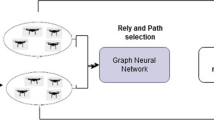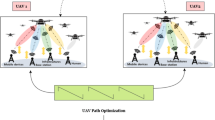Abstract
With the assistance of unmanned aerial vehicles (UAVs), wireless communication networks can provide connectivity to edge devices (EDs) even in challenging signal conditions. However, the forthcoming 6th generation mobile networks (6G) will demand increased energy, while EDs typically have limited energy resources. Furthermore, EDs often struggle to accurately track dynamic UAV positions due to time-lag mechanisms, hindering their ability to adapt emission energy dynamically. Additionally, fixed emission power settings on EDs contribute to their limited endurance. To address these challenges, we propose a deep learning-based energy-aware optimization technique (DEO) in this study. DEO dynamically adjusts the emission power of EDs to ensure that the received energy at the mobile relay UAV closely matches the receiver's sensitivity, while minimizing energy consumption. The edge server plays a crucial role by providing computational infrastructure for this task. Our approach employs the enhanced gradient-based graph recurrent neural network (Gradient GRNN) deep learning technique to predict the dynamic locations of relay UAVs. Based on these predictions, the emission energy of EDs is adaptively modified, enabling reliable connections with mobile relay UAVs while conserving energy. Through extensive simulations, we evaluate the effectiveness of various predictive networks under different time-delay conditions (0.4 s, 0.6 s, and 0.8 s). The results demonstrate that, even with communication delays, the algorithm achieves low weighted mean absolute percentage errors (WMAPE) of 0.54%, 0.80%, and 1.15%, respectively.








Similar content being viewed by others
References
Chen, C., Xiang, J., Ye, Z., Yan, W., Wang, S., Wang, Z., Chen, P., & Xiao, M. (2022). Deep learning-based energy optimization for edge device in UAV-aided communications. Drones, 6(6), 139.
Li, A., Masouros, C., Vucetic, B., Li, Y., & Swindlehurst, A. L. (2021). Interference exploitation precoding for multi-level modulations: Closed-form solutions. IEEE Transactions on Communications, 69(1), 291–308.
Li, B., Zhou, X., Ning, Z., Guan, X., & Yiu, K. (2022). C, Dynamic event-triggered security control for networked control systems with cyber-attacks: A model predictive control approach. Information Sciences, 612, 384–398.
Ding, G., Anselmi, N., Xu, W., Li, P., & Rocca, P. (2023). Interval-bounded optimal power pattern synthesis of array antenna excitations robust to mutual coupling. IEEE Antennas and Wireless Propagation Letters, 22, 2725–2729.
Yao, Y., Shu, F., Li, Z., Cheng, X., & Wu, L. (2023). Secure transmission scheme based on joint radar and communication in mobile vehicular networks. IEEE Transactions on Intelligent Transportation Systems, 24, 10027–10037.
Jiang, Y., & Li, X. (2022). Broadband cancellation method in an adaptive co-site interference cancellation system. International Journal of Electronics, 109(5), 854–874.
Zhao, J., Gao, F., Jia, W., Yuan, W., & Jin, W. (2023). Integrated sensing and communications for UAV communications with jittering effect. IEEE Wireless Communications Letters, 12(4), 758–62.
Zhao, Z., Xu, G., Zhang, N., & Zhang, Q. (2022). Performance analysis of the hybrid satellite-terrestrial relay network with opportunistic scheduling over generalized fading channels. IEEE Transactions on Vehicular Technology, 71(3), 2914–2924.
Almalki, F. A., Soufiene, B. O., Alsamhi, S. H., & Sakli, H. (2021). A low-cost platform for environmental smart farming monitoring system based on IoT and UAVs. Sustainability, 13(11), 5908.
Qi, W., Li, Q., Song, Q., Guo, L., & Jamalipour, A. (2021). Extensive edge intelligence for future vehicular networks in 6G. IEEE Wireless Communications, 28(4), 128–135.
Alsamhi, S. H., Almalki, F., Ma, O., Ansari, M. S., & Lee, B. (2021). Predictive estimation of optimal signal strength from drones over IoT frameworks in smart cities. IEEE Transactions on Mobile Computing., 22, 402–416.
Li, B., Zhang, M., Rong, Y., & Han, Z. (2021). Transceiver optimization for wireless powered time-division duplex MU-MIMO systems: Non-robust and robust designs. IEEE Transactions on Wireless Communications, 21(6), 4594–4607.
Bai, X., Huang, M., Xu, M., & Liu, J. (2023). Reconfiguration optimization of relative motion between elliptical orbits using Lyapunov–Floquet transformation. IEEE Transactions on Aerospace and Electronic Systems, 59(2), 923–936.
Guo, F., Zhou, W., Lu, Q., & Zhang, C. (2022). Path extension similarity link prediction method based on matrix algebra in directed networks. Computer Communications, 187, 83–92.
Gupta, A., Sundhan, S., Gupta, S. K., Alsamhi, S. H., & Rashid, M. (2020). Collaboration of UAV and HetNet for better QoS: A comparative study. International Journal of Vehicle Information and Communication Systems, 5(3), 309–333.
Saif, A., Dimyati, K.B., Noordin, K.A.B., Shah, N.S.M., Alsamhi, S.H., Abdullah, Q. & Farah, N. (2021). Distributed clustering for user devices under unmanned aerial vehicle coverage area during disaster recovery. arXiv:2103.07931.
Cao, K., Wang, B., Ding, H., Lv, L., Dong, R., Cheng, T., & Gong, F. (2021). Improving physical layer security of uplink NOMA via energy harvesting jammers. IEEE transactions on information forensics and security, 16, 786–799.
Alsamhi, S. H., Almalki, F. A., Al-Dois, H., Shvetsov, A. V., Ansari, M. S., Hawbani, A., Gupta, S. K., & Lee, B. (2021). Multi-drone edge intelligence and SAR smart wearable devices for emergency communication. Wireless Communications and Mobile Computing, 2021, 1–12.
Jiang, S., Zhao, C., Zhu, Y., Wang, C., Du, Y., Lei, W., & Wang, L. (2022). A practical and economical ultra-wideband base station placement approach for indoor autonomous driving systems. Journal of advanced transportation, 1–12, 2022.
Alsharif, M. H., Kelechi, A. H., Albreem, M. A., Chaudhry, S. A., Zia, M. S., & Kim, S. (2020). Sixth generation (6G) wireless networks: Vision, research activities, challenges and potential solutions. Symmetry, 12(4), 676.
Zhang, C., Xiao, P., Zhao, Z., Liu, Z., Yu, J., Hu, X., & Li, G. (2023). A wearable localized surface plasmons antenna sensor for communication and sweat sensing. IEEE Sensors Journal, 23(11), 11591–11599.
Luo, J., Zhao, C., Chen, Q., & Li, G. (2022). Using deep belief network to construct the agricultural information system based on Internet of Things. The Journal of Supercomputing, 78(1), 379–405.
Xiao, Z., Shu, J., Jiang, H., Min, G., Liang, J., & Iyengar, A. (2022). Toward collaborative occlusion-free perception in connected autonomous vehicles. IEEE Transactions on Mobile Computing. https://doi.org/10.1109/TMC.2023.3298643
Chen, L., Chen, P., & Lin, Z. (2020). Artificial intelligence in education: A review. IEEE Access, 8, 75264–75278.
Liu, C., Yuan, W., Wei, Z., Liu, X., & Ng, D. W. K. (2020). Location-aware predictive beamforming for UAV communications: A deep learning approach. IEEE Wireless Communications Letters, 10(3), 668–672.
Cheng, B., Wang, M., Zhao, S., Zhai, Z., Zhu, D., & Chen, J. (2017). Situation-aware dynamic service coordination in an IoT environment. IEEE/ACM Transactions On Networking, 25(4), 2082–2095.
Liu, X., Zhou, G., Kong, M., Yin, Z., Li, X., Yin, L., & Zheng, W. (2023). Developing multi-labelled corpus of twitter short texts: A semi-automatic method. Systems, 11(8), 390.
Alahdadi, A., Safaei, A. A., & Ebadi, M. J. (2023). A truthful and budget-balanced double auction model for resource allocation in cloud computing. Soft Computing, 27, 18263–18284.
Wang, X., Wang, Y., Javaheri, Z., Almutairi, L., Moghadamnejad, N., & Younes, O. S. (2023). Federated deep learning for anomaly detection in the internet of things. Computers and Electrical Engineering, 108, 108651.
Liu, Q., Kosarirad, H., Meisami, S., Alnowibet, K. A., & Hoshyar, A. N. (2023). An optimal scheduling method in IoT-fog-cloud network using combination of Aquila optimizer and African vultures optimization. Processes, 11(4), 1162.
Peivandizadeh, A. & Molavi, B. (2023). Compatible authentication and key agreement protocol for low power and Lossy network in IoT environment. Available at SSRN 4454407.
Dehghani, F. & Larijani, A. (2023). Average portfolio optimization using multi-layer neural networks with risk consideration. Available at SSRN.
Yang, H. Q., Zeng, Y. Y., Lan, Y. F., & Zhou, X. P. (2014). Analysis of the excavation damaged zone around a tunnel accounting for geostress and unloading. International Journal of Rock Mechanics and Mining Sciences, 69, 59–66.
Yang, H., Wang, Z., & Song, K. (2020). A new hybrid grey wolf optimizer-feature weighted-multiple kernel-support vector regression technique to predict TBM performance. Engineering with Computers, 38, 2469–2485.
Chen, J., Wen, L., Bi, C., Liu, Z., Liu, X., & YinZheng, L. W. (2023). Multifractal analysis of temporal and spatial characteristics of earthquakes in Eurasian seismic belt. Open Geosciences, 15(1), 2023.
Lv, Z., Qiao, L., Hossain, M. S., & Choi, B. J. (2021). Analysis of using blockchain to protect the privacy of drone big data. IEEE Network, 35(1), 44–49.
Zhou, D., Sheng, M., Li, J., & Han, Z. (2023). Aerospace integrated networks innovation for empowering 6G: A survey and future challenges. IEEE Communications Surveys & Tutorials, 25(2), 975–1019.
Anand, A., De Veciana, G., & Shakkottai, S. (2020). Joint scheduling of URLLC and eMBB traffic in 5G wireless networks. IEEE/ACM Transactions on Networking, 28(2), 477–490.
Lu, S., Ding, Y., Liu, M., Yin, Z., Yin, L., & Zheng, W. (2023). Multiscale feature extraction and fusion of image and text in VQA. International Journal of Computational Intelligence Systems, 16(1), 54.
Yang, H., Chen, C., Ni, J., & Karekal, S. (2023). A hyperspectral evaluation approach for quantifying salt-induced weathering of sandstone. Science of The Total Environment, 885, 163886.
Author information
Authors and Affiliations
Corresponding author
Ethics declarations
Conflicts of interest
There is no conflicts of interest.
Additional information
Publisher's Note
Springer Nature remains neutral with regard to jurisdictional claims in published maps and institutional affiliations.
Rights and permissions
Springer Nature or its licensor (e.g. a society or other partner) holds exclusive rights to this article under a publishing agreement with the author(s) or other rightsholder(s); author self-archiving of the accepted manuscript version of this article is solely governed by the terms of such publishing agreement and applicable law.
About this article
Cite this article
Tang, D., Zhang, Q. UAV 5G: enabled wireless communications using enhanced deep learning for edge devices. Wireless Netw (2023). https://doi.org/10.1007/s11276-023-03589-x
Accepted:
Published:
DOI: https://doi.org/10.1007/s11276-023-03589-x




